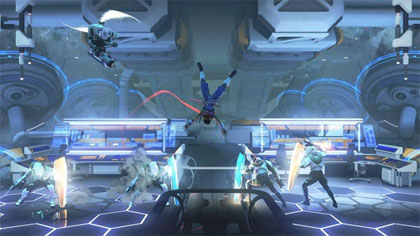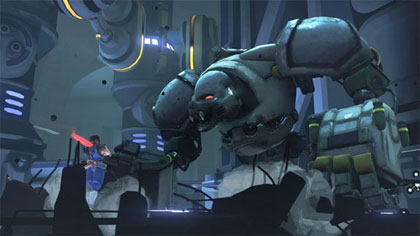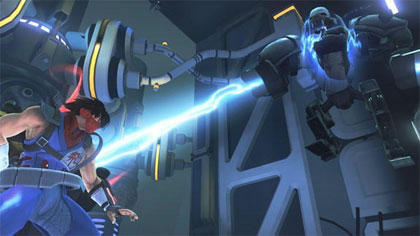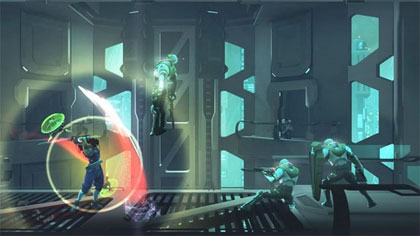- CLASSIC MAGAZINES
- REVIEW CREW
A show recapping what critics thought back
when classic games first came out! - NEXT GENERATION'S BEST & WORST
From the worst 1-star reviews to the best
5-stars can offer, this is Next Generation! - NINTENDO POWER (ARCHIVE)
Experience a variety of shows looking at the
often baffling history of Nintendo Power! - MAGAZINE RETROSPECTIVE
We're looking at the absolutely true history of
some of the most iconic game magazines ever! - SUPER PLAY'S TOP 600
The longest and most ambitious Super NES
countdown on the internet! - THEY SAID WHAT?
Debunking predictions and gossip found
in classic video game magazines! - NEXT GENERATION UNCOVERED
Cyril is back in this spin-off series, featuring the
cover critic review the art of Next Generation! - HARDCORE GAMER MAGAZING (PDF ISSUES)
Download all 36 issues of Hardcore Gamer
Magazine and relive the fun in PDF form!
- REVIEW CREW
- ELECTRONIC GAMING MONTHLY
- ELECTRONIC GAMING MONTHLY RANKS
From Mario to Sonic to Street Fighter, EGM
ranks classic game franchises and consoles! - ELECTRONIC GAMING MONTHLY BEST & WORST
Counting down EGM’s best and worst reviews
going year by year, from 1989 – 2009! - ELECTRONIC GAMING BEST & WORST AWARDS
11-part video series chronicling the ups and
downs of EGM’s Best & Worst Awards!
- ELECTRONIC GAMING MONTHLY RANKS
- GAME HISTORY
- GAME OVER: STORY BREAKDOWNS
Long-running series breaking down game
stories and analyzing their endings! - A BRIEF HISTORY OF GAMING w/ [NAME HERE]
Real history presented in a fun and pithy
format from a variety of game historians! - THE BLACK SHEEP
A series looking back at the black sheep
entries in popular game franchises! - INSTANT EXPERT
Everything you could possibly want to know
about a wide variety of gaming topics! - FREEZE FRAME
When something familiar happens in the games
industry, we're there to take a picture! - I'VE GOT YOUR NUMBER
Learn real video game history through a series
of number-themed episodes, starting at zero! - GREAT MOMENTS IN BAD ACTING
A joyous celebration of some of gaming's
absolute worst voice acting!
- GAME OVER: STORY BREAKDOWNS
- POPULAR SHOWS
- DG NEWS w/ LORNE RISELEY
Newsman Lorne Riseley hosts a regular
series looking at the hottest gaming news! - REVIEW REWIND
Cyril replays a game he reviewed 10+ years
ago to see if he got it right or wrong! - ON-RUNNING FEUDS
Defunct Games' longest-running show, with
editorials, observations and other fun oddities! - DEFUNCT GAMES QUIZ (ARCHIVE)
From online quizzes to game shows, we're
putting your video game knowledge to the test!- QUIZ: ONLINE PASS
Take a weekly quiz to see how well you know
the news and current gaming events! - QUIZ: KNOW THE GAME
One-on-one quiz show where contestants
find out if they actually know classic games! - QUIZ: THE LEADERBOARD
Can you guess the game based on the classic
review? Find out with The Leaderboard!
- QUIZ: ONLINE PASS
- DEFUNCT GAMES VS.
Cyril and the Defunct Games staff isn't afraid
to choose their favorite games and more! - CYRIL READS WORLDS OF POWER
Defunct Games recreates classic game
novelizations through the audio book format!
- DG NEWS w/ LORNE RISELEY
- COMEDY
- GAME EXPECTANCY
How long will your favorite hero live? We crunch
the numbers in this series about dying! - VIDEO GAME ADVICE
Famous game characters answer real personal
advice questions with a humorous slant! - FAKE GAMES: GUERILLA SCRAPBOOK
A long-running series about fake games and
the people who love them (covers included)! - WORST GAME EVER
A contest that attempts to create the worst
video game ever made, complete with covers! - LEVEL 1 STORIES
Literature based on the first stages of some
of your favorite classic video games! - THE COVER CRITIC
One of Defunct Games' earliest shows, Cover
Critic digs up some of the worst box art ever! - COMMERCIAL BREAK
Take a trip through some of the best and
worst video game advertisements of all time! - COMIC BOOK MODS
You've never seen comics like this before.
A curious mix of rewritten video game comics!
- GAME EXPECTANCY
- SERIES ARCHIVE
- NINTENDO SWITCH ONLINE ARCHIVE
A regularly-updated list of every Nintendo
Switch Online release, plus links to review! - PLAYSTATION PLUS CLASSIC ARCHIVE
A comprehensive list of every PlayStation
Plus classic release, including links! - RETRO-BIT PUBLISHING ARCHIVE
A regularly-updated list of every Retro-Bit
game released! - REVIEW MARATHONS w/ ADAM WALLACE
Join critic Adam Wallace as he takes us on a
classic review marathon with different themes!- DEFUNCT GAMES GOLF CLUB
Adam Wallace takes to the links to slice his way
through 72 classic golf game reviews! - 007 IN PIXELS
Adam Wallace takes on the world's greatest spy
as he reviews 15 weeks of James Bond games! - A SALUTE TO VAMPIRES
Adam Wallace is sinking his teeth into a series
covering Castlevania, BloodRayne and more! - CAPCOM'S CURSE
Adam Wallace is celebrating 13 days of Halloween
with a line-up of Capcom's scariest games! - THE FALL OF SUPERMAN
Adam Wallace is a man of steel for playing
some of the absolute worst Superman games! - THE 31 GAMES OF HALLOWEEN
Adam Wallace spends every day of October afraid
as he reviews some of the scariest games ever! - 12 WEEKS OF STAR TREK
Adam Wallace boldly goes where no critic has
gone before in this Star Trek marathon!
- DEFUNCT GAMES GOLF CLUB
- DAYS OF CHRISTMAS (ARCHIVE)
Annual holiday series with themed-episodes
that date all the way back to 2001!- 2015: 30 Ridiculous Retro Rumors
- 2014: 29 Magazines of Christmas
- 2013: 29 Questionable Power-Ups of Christmas
- 2012: 34 Theme Songs of Christmas
- 2011: 32 Game Endings of Christmas
- 2010: 31 Bonus Levels of Christmas
- 2009: 30 Genres of Christmas
- 2008: 29 Controls of Christmas
- 2007: 34 Cliches of Christmas
- 2006: 33 Consoles of Christmas
- 2005: 32 Articles of Christmas
- 2004: 31 Websites of Christmas
- 2003: 29 Issues of Christmas
- 2002: 28 Years of Christmas
- 2001: 33 Days of Christmas
- NINTENDO SWITCH ONLINE ARCHIVE
- REVIEW ARCHIVE
- FULL ARCHIVE
Strider
Even though he has only starred in a few old school action games, there's a reason why so many people continue to love Strider Hiryu. It's not for his witty banter or diverse fashion sense, but rather because this futuristic ninja has one of the coolest weapons in video game history. It also doesn't hurt that he's incredibly agile; able to quickly climb, slide and dangle off of nearly every ledge and wall. And while many games have attempted to recreate the magic of Strider, few get the formula right.
Now, a quarter-century after the release of the arcade hit, Capcom is finally bringing Strider Hiryu out of retirement. Thanks to California-based Double Helix Games (who also recently rebooted the Killer Instinct franchise), one of my favorite characters is getting the next-generation treatment he deserves.
 Click For the Full Picture Archive
Click For the Full Picture ArchiveFor better or worse, this new Strider feels like a checklist of everybody's favorite moments from the original 16-bit game. Our hero, a sword-wielding ninja with a long flowing scarf, swoops into Kazakh City to beat up Grandmaster Meio's robot army. Along the way we'll meet up with a giant mechanical gorilla, three Chun Li lookalikes and one very angry flying serpent. The premise, locations and bosses may look familiar, but the developers have done a good job of fleshing out the story and wrapping these disparate pieces into one somewhat coherent narrative.
Instead of being a straight-up action game like the arcade classic, this 21st century Strider shares some of the Metroid/Castlevania-style elements found in the far less exciting 8-bit NES game. Each of the various stages is connected, allowing players to revisit the different parts of Kazakh City. This is important, as Strider Hiryu is constantly earning abilities that open up new parts of the world.
While none of Strider's upgrades are especially original, they do go a long way to turning our hero into an unstoppable killing machine. Sure there's the double jump and slide, but Hiryu is also able to freeze enemies, throw a variety of projectiles, command several mechanical animals and even teleport in any direction. Although some of the new abilities are tied to defeating specific types of enemies, I never got bored of going back and using my super-powered moves to pick on Grandmaster Meio's most basic robot guards.
 Click For the Full Picture Archive
Click For the Full Picture ArchiveEven without the different types of weapons and special abilities, Strider Hiryu remains one of the most compelling action heroes working today. It's the sword, which he swings so fast that the human eye can barely see it. It leaves a quick outline, cutting through enemies with one satisfying flash of light. This time around players can aim the sword, as well as use it to launch enemies into the air to set up combos. These additions are smart and help add some depth to the combat, though it's hard to beat Strider's awesome sword.
While most remember Strider as being a straight-forward action game, the truth is that the original arcade title had a lot more going on than people remember. One stage may be all about climbing, while the next has our hero jumping between flying machines. Some of the stages even added new wrinkles to the gameplay, such as portions that see the player literally walking on the ceiling and orbiting a floating sphere. I was happy to see that this brand new Strider not only recreated these moments, but also found ways of making them relevant to the overall story.
When it comes down to it, I'm impressed that Double Helix managed to figure out how to draw a through line between all these weird story beats. This is, after all, a game with a huge mechanical gorilla, a large flying battle ship, gravity defying spheres and strong overtones to Soviet-era Russia. And did I mention that the three Chun Li lookalikes are finally explained? The story may not make a ton of sense, but I give credit to the developers for finding a way of working all these pieces into one very zany quest.
 Click For the Full Picture Archive
Click For the Full Picture ArchiveUnfortunately, sometimes the game is a little too zany for its own good. The supporting cast ranges from purposely cheesy to just plain bad. It doesn't help that Strider Hiryu often spouts cringe-inducing lines. There are a few great moments that help fill in the story, but there are far too many cut scenes dedicated to annoying characters whose only purpose is to send Strider on a fetch quest.
Speaking of fetch quests, I found the missions and open world structure ultimately stifled the arcade game's urgency. Instead of constantly moving forward, much of this new Strider involves backtracking and fighting through the same areas multiple times. To the game's credit, it does keep the action fresh by constantly offering upgrades and new abilities, but there's something about this sub-genre of game that doesn't feel as consistently exciting as that 16-bit arcade classic.
The connected world also limits the variety of backgrounds Strider experiences. Players will see a lot of Kazakh City, along with a prison, laboratory, subway station, airship and more. Each of these areas has a unique look and new types of enemies, but most are indoors and start to run together after a while. Thankfully, Strider mixes things up with moments of anti-gravity and other fun quirks, but I was disappointed that the actual stages weren't as diverse as the arcade game. Some of my favorite stages from the original were the snow-covered mountains and jungles filled with robot dinosaurs, but neither of these areas are explored in this new Strider. Instead we get hours of drab indoor locales.
 Click For the Full Picture Archive
Click For the Full Picture ArchiveThankfully, the combat and play mechanics are strong enough to make up for many of these disappointments. It's also a lot of fun to explore the world, and Hiryu's many abilities make reaching tough areas a snap. This new game makes good use out of Strider's ability to climb walls and hang from ledges. Best of all, there are a lot of upgrades and collectables that make searching each stage worthwhile.
Although I complain about the indoor stages, I was impressed by Strider's overall look. Hiryu's sword has never looked shinier, creating sparks and other lighting effects as it rips through the robot fiends. The backgrounds are full of believable details and Kazakh City has never looked better. There are also a number of impressive boss fights, including one on the top of a flying serpent and another involving those floating spheres I talked about earlier. There's nothing about this game that couldn't be done on the PlayStation 3, but it certainly looks sharp on Sony's next-generation console.
While I will likely always prefer the original arcade game, this brand new Strider is a great start to what will hopefully be an ongoing series. I would love to see a sequel dig up those robot dinosaurs and finally make sense of Journey from Darkness: Strider Returns, the unofficial Genesis follow-up by Tiertex. This reboot is not perfect, but it's great to have Strider Hiryu back in action. He's been missed.
HOME |
CONTACT |
NOW HIRING |
WHAT IS DEFUNCT GAMES? |
NINTENDO SWITCH ONLINE |
RETRO-BIT PUBLISHING
Retro-Bit |
Switch Planet |
The Halcyon Show |
Same Name, Different Game |
Dragnix |
Press the Buttons
Game Zone Online | Hardcore Gamer | The Dreamcast Junkyard | Video Game Blogger
Dr Strife | Games For Lunch | Mondo Cool Cast | Boxed Pixels | Sega CD Universe | Gaming Trend
Game Zone Online | Hardcore Gamer | The Dreamcast Junkyard | Video Game Blogger
Dr Strife | Games For Lunch | Mondo Cool Cast | Boxed Pixels | Sega CD Universe | Gaming Trend
Copyright © 2001-2025 Defunct Games
All rights reserved. All trademarks are properties of their respective owners.
All rights reserved. All trademarks are properties of their respective owners.





























